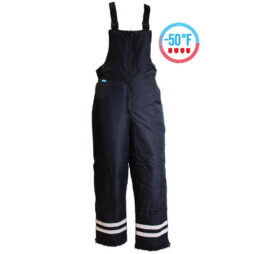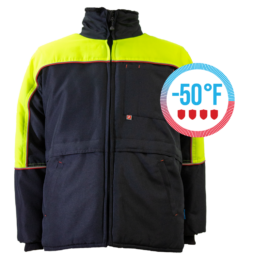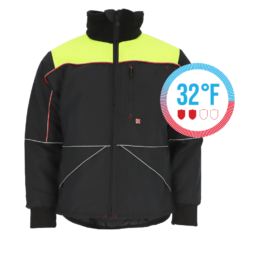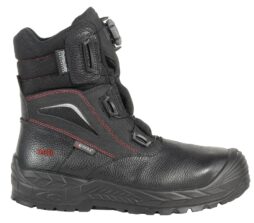
What to Wear in a Cold Storage Warehouse
Choosing the right workwear can make all the difference for both comfort and productivity when working in coolers or cold storage. Making sure that you or your team are outfitted with the right equipment can be complicated, but here at Avaska, we want to help you make the right call for your temperature conditions and budget.
When asking yourself “What should I wear when working in a cooler?” there are a few things to consider:
- How cold does your warehouse or workplace get?
- How long are you typically working in the coldest conditions?
- What kind of surfaces are you working on and are they slippery?
- What kind of work are you doing and how much mobility do you need?
- Is there machinery around you that you need to be visible to?
Choosing the Right Insulation Weight
The first place to start is with how cold your workplace gets during work hours as well as the type of activities you are doing Because of the varying types of insulation and because garment construction has a lot to do with warmth you cannot rely on insulation weight exclusively to determine the warmth of insulated workwear. We’ve tried to take the guesswork out of this for you by rating our gear according to the coldest temperature it can be worn in comfortably. In most cases, this is also backed up by lab testing and certifications including ANSI/ISEA 201-2012 and EN 342.
In general, you want to match the temperature ranges in the table below for your jackets, bibs, gloves, and shoes:
| Temperature | Avaska Product Category |
| 51°F + | Ambient |
| 32°F to 50°F | Cooler |
| -25°F to 32°F | Freezer |
| -60°F to -26°F | ExtremeFreeze |
Often, cold storage warehouses and coolers fall into the Cooler or Ambient temperature ranges, meaning you’ll want to look for workwear that is rated for use in temperatures above freezing. This also means you can choose more lightweight workwear which is comfortable and flexible.
Your activity level also has a lot to do with the type of gear you use. If you are a forklift driver you will need a garment that has a higher insulation rating than if you are a selector who is moving around more. For example, if you are primarily stationary in a -25ºF (-32°C) you may need to select a jacket that is rated down to -50°F (-45°C). On the other hand, if you are constantly moving in -10°F (-23°C) you may be able to use a suit that is rated for 0ºF (-18ºC).
At Avaska we offer two product ranges that are suitable for this kind of work environment:
Both of these product series has a variety of options for full kits that include both jackets and bibs, pants, or overalls.
-
 Alpine Freezer Bib$181.00
Alpine Freezer Bib$181.00 -
 Alpine Zero Bib$149.00
Alpine Zero Bib$149.00 -
 Avaska Alpine Zero Jacket 0°F (-18°C)$149.00
Avaska Alpine Zero Jacket 0°F (-18°C)$149.00 -
 Avaska Alpine Freezer Jacket -50°F (-45°C)$181.00
Avaska Alpine Freezer Jacket -50°F (-45°C)$181.00 -
 Taiga Cooler Bib$129.00
Taiga Cooler Bib$129.00 -
 Avaska Taiga Cooler Jacket 32ºF (0ºC)$127.00
Avaska Taiga Cooler Jacket 32ºF (0ºC)$127.00
Best Boots for Cold Storage Work
Just like insulation weight, your specific warehouse conditions can affect how you should outfit your feet while on the job. At Avaska we offer a wide range of cooler boot and shoe options, as well as food processing and safety footwear that is specifically designed for those specialized conditions.
In footwear, sole construction is extremely important especially if you’ll be on your feet in a freezer or cold storage warehouse all day. The boot should have a quality sole and footbed to ensure that you keep the cold from coming through from the bottom. In fact, in many cases, a quality sole and footbed are more important than the insulation level of your boot. If you or your teamwork in a food processing facility or another facility with loose ice and water, you should consider looking for food processing-specific boots or waterproof footwear. At Avaska, you can also find a full range of food processing equipment.
For many teams, safety is paramount. Whether you need safety-toed shoes or boots with specialized soles to provide grip on wet or oily surfaces, you will find a wide selection of safety footwear when you shop with us.
When You Should Wear Hi-Vis Gear
High visibility workwear is a must in many warehouses. Any time your team could be obscured by low lighting, mist, or shelving and storage you should ensure that they are equipped with enhanced visibility cooler workwear or take it to the next level with gear that is compliant with ANSI/ISEA 107 Type R Class 2 or 3. ..
Any warehouse that operates equipment like forklifts, scissor lifts, or other vehicles in or around the warehouse should also ensure that their entire team has access to hi-visibility gear while working in high traffic areas. Whether you choose high visibility vests or opt for gear with high vis elements built into their designs, Avaska can help you find the right hi-vis kit for your team:
Try Avaska Medical Warehousing Workwear in House or Order Samples
At Avaska, we’re always excited to prove the quality of our products to you and your employees. Contact us to set up a visit from one of our team members or order samples online for your team to test on-site.
Order today, Warm tomorrow.



